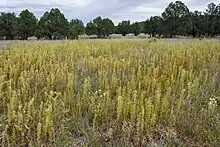| Hill's lupine | |
|---|---|
 | |
| Scientific classification | |
| Kingdom: | Plantae |
| Clade: | Tracheophytes |
| Clade: | Angiosperms |
| Clade: | Eudicots |
| Clade: | Rosids |
| Order: | Fabales |
| Family: | Fabaceae |
| Subfamily: | Faboideae |
| Genus: | Lupinus |
| Species: | L. hillii |
| Binomial name | |
| Lupinus hillii | |
Lupinus hillii, commonly known as Hill's lupine, is a species of lupine native to Arizona and some parts of New Mexico.[1]
Subspecies
Lupinus hillii has three subspecies, including:[1]
Lupinus hillii var. arizonicus, native to Arizona and New Mexico.
Lupinus hillii var. hillii, native to New Mexico.
Lupinus hillii var. osterhoutianus, native to Arizona and New Mexico.
Description
Hill's lupine can grow up to 2 feet. It grows either upright or horizontally. There is no hair on the stems, but the leaflets are hairy. The green leaves are palmately compound leaves, with 5 to 9 leaflets. The flowers are a variety of colors, including blue, violet, lavender, and purple. The fruit produced is a legume pod. The fruit color starts at green and turns to brown.[2][3]
Distribution and habitat
Its flowering season is May–September.[4] The elevation that you could find the plant is between 6,000 and 9,000 feet, in Ponderosa pine forests.[2][3]
Lupinus hillii has a global status of G3, which means it is vulnerable, it also has a local status of S3 in New Mexico.[5]
References
- 1 2 "USDA Plants Database". plants.usda.gov. Retrieved 2023-06-21.
- 1 2 "Lupinus hillii, Hill's Lupine, Southwest Desert Flora". southwestdesertflora.com. Retrieved 2023-06-21.
- 1 2 "Species Detail Forb". cals.arizona.edu. Retrieved 2023-06-21.
- ↑ "Lupinus hillii Greene". www.gbif.org. Retrieved 2023-07-23.
- ↑ "NatureServe Explorer 2.0". explorer.natureserve.org. Retrieved 2023-06-21.